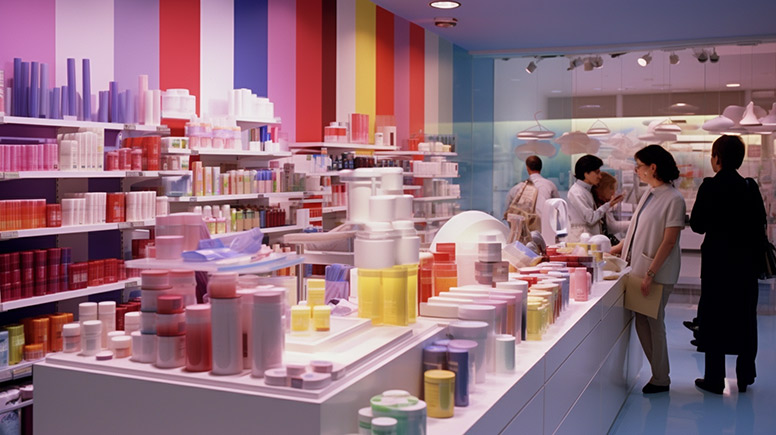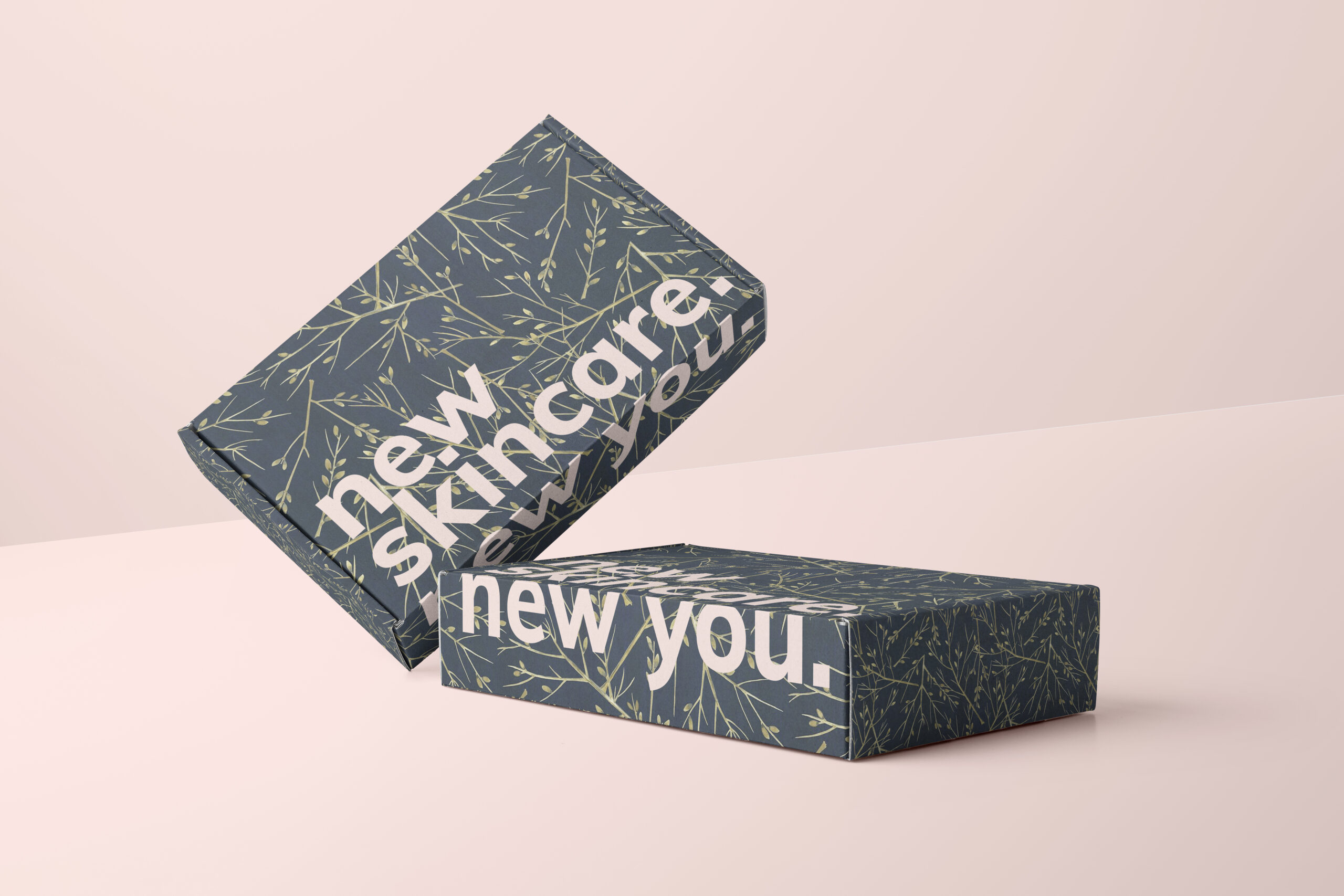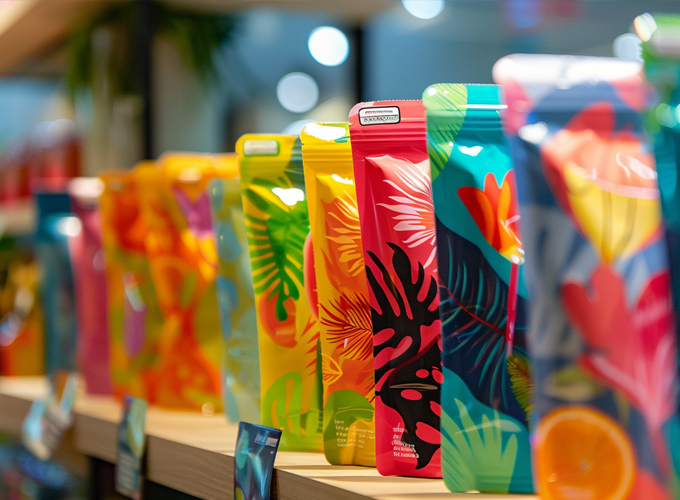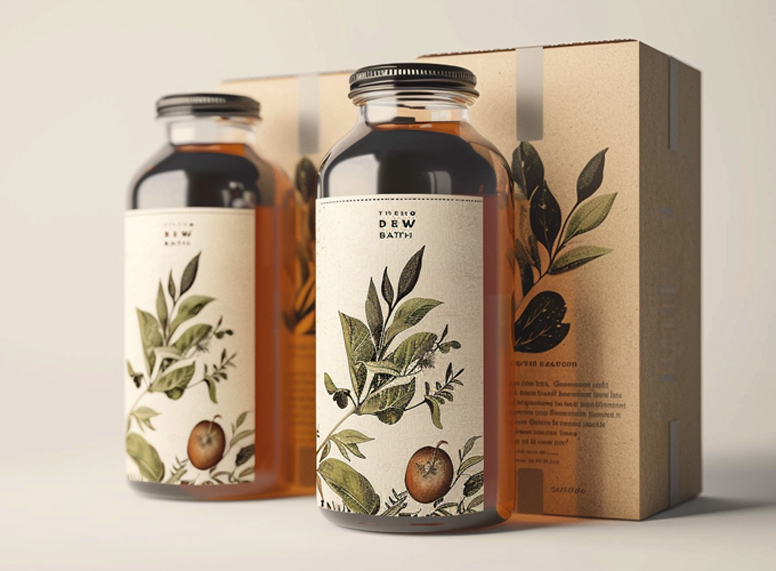Our Guide to Mastering Custom Packaging Design

By Brad Holmes|May 13, 2024|11 mins read
When your business is your product, every detail matters. Amidst a sea of competitors, your brand is what sets you apart and sets the tone for your customer experience. In fact, 72% of American consumers say product packaging design influences their purchase decisions!
Want to take your product packaging and custom labels to the next level? Here are some tips and tricks that are tried and true to help you get the most out of your custom product packaging, before you even task it to your graphic designer.

At a Glance
Understand Your Brand Identity & Target Audience
To ensure your beautiful custom packaging is also effective, it’s important to have a deep understanding of your brand’s identity. Here are some questions that can help you define your brand identity:
- What are the core values and mission of your brand?
- What sents your brand or product apart from competitors?
- How do you want to be perceived by customers?
Next, pinpoint your target audience. What do they like or very specifically dislike? What do they value? How do they shop? With this information, you can tailor your packaging design to appeal to their preferences and effectively show off the value of your product.
When your brand and audience are clearly defined, you can be confident that the product packaging you’re designing aligns with your brand image and audience messaging.
Incorporating Visual Elements
Make your product packaging pop! The eye is naturally drawn to exciting, unique, or bright visual elements, and by incorporating these into your packaging or labels your brand will easily stand out.
If you’re new to custom designed packaging, take some time to learn the principles of design that can help you create visually appealing compositions that will delight your customers before they even open the box.
This guide, 11 Principles of Design (and How to Use Them), is a great starting point to understand the intricacies of principles like balance, proportion, contrast, and more. Some principles are simply for aesthetic reasons, while others could be helpful tools for customers with visual impairments.
Choosing the Right Materials
Not every product needs the same type of packaging (but you already knew that!). Below are some of the options you may need to create custom designs for to wow your customers and grow your business.

Product Cartons and Boxes
Custom product boxes make your products stand out on the shelf and showcase your brand. Folded product cartons can be personalized with a variety of unique print finishes from spot UV to specialized inks that offer a premium look and feel for your consumer packaged goods and more.

Mailer Boxes
Custom mailer boxes are perfect for shipping your products to consumers, e-commerce goods, or branded subscription boxes. Made from durable corrugate, mailer boxes can be customized to your product’s needs, or come in standard shipping box sizes for super simple ordering.

Flex Packaging
From custom lay-flat pouches to branded stand-up pouches, flexible packaging options are ideal for cannabis products, nutraceuticals, and delicious food industry goods. Flex packaging is offered in a variety of sizes and finishes, including added features like hang holes or zipper closures to keep your products safe and fresh.

Printed Labels
More than a sticker, personalized roll and die-cut labels offer a way to quickly and easily brand high-volume orders. From food packaging labels to product labels, custom printed labels are simple and effective when used on jarred or bottled products, as well as on boxes. Plus, with waterproof label options, breweries, wineries, and distilleries can keep their brand front-and-center, even in when kept in the fridge or an icy cooler.

Utilize Sustainable Packaging Solutions
Now that you’ve done the work to define your brand’s mission and understand what speaks best to your customers and potential audience, the next thing you should think about is how to make a smart impact for the environment.
Even if your customers aren’t specifically focused on sustainability or that isn’t a conscious factor in how they make purchasing decisions, a 2023 study showed that green practices, which includes using sustainable packaging materials and solutions, develops greater customer satisfaction, which leads to positive customer behaviors like loyalty, word-of-mouth, and willingness to pay more.
Thankfully, you don’t need to choose between custom packaging designed for ecommerce or local businesses and affordable sustainable packaging solutions. Print on demand technology with low minimums allows you print only the exact amount of mailer boxes, custom product packaging, flex packages, or die cut labels you need. This reduces waste and saves your company money.
Another way to promote sustainability at your company is to use recycled materials produced at a Net Zero Emissions printing materials.
Balancing Aesthetics with Functionality
When creating your product boxes, for example your custom cosmetic packaging design, it’s crucial to consider both the beauty of your product packaging and how it will function.
Do you expect the packaging to be opened and closed a number of times? Consider a heavier box weight to strengthen the package and endure the wear and tear. If it’s a food or cannabis product, keep it fresh with a zipper closure for longer-lasting enjoyment.
Here are some other packaging design tips to consider:
- Prioritize structural integrity for protection during shipping
- Use durable materials and practical features like inserts to secure your product
- Incorporate branding elements throughout, including stickers, for a cohesive look
- Ensure the essential information is clear when designing the visual look
Gather Feedback from Your Customers
An often overlooked aspect of custom designed packaging is… updated custom design packaging.
The beauty of on demand printing is the ability to be agile in your product packaging delivery. So when feedback comes in from customers – both positive and constructive – you can made the appropriate changes and improve the customer experience.
Regularly gathering feedback to refine the design and create packaging that enhances the experience of receiving your product is an easy way to make your customers happy and coming back for more.
Here are a few ways to easily gather feedback from your customers that can help update your custom product packaging:
- Send short surveys, using tools like Google Forms or SurveyMonkey, to ask about packaging design, ease of use, and overall satisfaction
- Include feedback forms with the packaging itself (PackStudio can help with those, too!). Don’t forget to include a pre-paid return envelope or easy-to-find online submission option
- Engage with your customers on social media and/or monitor comments and direct messages
- Send targeted emails to existing customers to ask for feedback on recent purchases. Offering incentives, like discounts on future purchases, can help encourage participation
Don’t be afraid to talk to your customers! Whether at the store, an open-air market, or via the phone, listen to your customers suggestions and concerns.
How Do Customers Most Benefit from Packaging Design?
Effective packaging design goes beyond mere aesthetics; it plays a crucial role in enhancing the overall customer experience and driving positive brand perception. Here are five key ways customers benefit from well-thought-out custom packaging design:
Improved Product Experience
Your packaging may be the first point of contact between your customer and your product. When designed effectively, packaging can enhance the entire experience by providing clear information, convenient handling, and an engaging unboxing experience. Intuitive packaging design ensures that customers can easily access and use the product, leading to higher satisfaction levels.
Enhanced Perceived Value
Thoughtfully designed packaging communicates quality and value to customers. Gorgeous packaging with premium materials and finishes can elevate the perceived value of the product, making it more desirable to consumers. By investing in high-quality packaging, brands can potentially command higher prices and differentiate themselves from competitors in the market.
Positive Brand Associations
Custom packaging design is a powerful tool for shaping brand perception and fostering positive associations in the minds of consumers. Consistent branding elements, such as logos, colors, and messaging on everything from the mailer boxes it comes in to the custom labels wrapped around the bottle, create a cohesive brand identity that resonates with customers. Well-designed packaging can evoke emotions and convey brand values, strengthening the bond between the customer and the brand.
Facilitating Brand-Customer Interaction
Packaging serves as a tangible representation of the brand, offering opportunities for meaningful interactions with customers. Interactive packaging features, such as QR codes or personalized messages, can engage customers on a deeper level and foster brand loyalty. By leveraging custom packaging as a medium for communication, brands can forge stronger connections with their target audience and existing customers.
Customer Satisfaction and ROI
Effective packaging design has a real impact on customer satisfaction, leading to measurable returns on investment (ROI).
Across industries, from beauty and cosmetics to art and cannabis, strategic packaging designs have resulted in increased sales, improved brand perception, and enhanced customer loyalty. These case studies serve as valuable insights for brands looking to optimize their packaging strategies and achieve measurable results.
Trends and Innovations in Custom Packaging Design
Custom packaging design is continually evolving, and differs from industry to industry. Here are four key trends to keep in mind as you create your custom designed packaging.
Personalization and Mass Customization
Brands that leverage digital printing technology are able to create personalized packaging solutions that resonate with their customers. Even for growing brands, you can still utilize mass customization to create unique packaging experiences for all, without sacrificing efficiency or scalability
Interactive Packaging Solutions
Multi-sensory experiences, from access to VR experiences to unique scents sprayed on packaging, give brands the ability to deliver additional content or brand recognition tools to enhance the customer experience.
Integration of Technology
Even with a physical product being purchased and shipped, technology is still innovating the unboxing experience. QR codes, for example, allow for easy access to how-to videos, exclusive content, and more, to immerse the customer in your brand’s story and deepen their engagement.
Eco-friendly Packaging Innovations
Sustainability is consistently growing as a top priority for both brands and consumers. Utilize environmentally friendly products and printing services to reduce waste and lower your carbon footprint. Your customers, and the Earth, will appreciate it!
Essential Design Tips for Packaging Design
Designing for packaging print involves meticulous attention to detail to ensure the final product looks as intended. Whether you are a seasoned designer or a novice, these tips will help you navigate the complexities of packaging design, ensuring high-quality, professional results. Here’s a guide covering essential aspects such as color recommendations, raster images, vector graphics, and typography.
Color Recommendations
Black & Gray
- Black Text or Linework: Always set black text or linework to a CMYK value of 0-0-0-100. This ensures that only black ink is used, providing crisp and sharp text. Avoid using composite or “rich” black for text as it can result in fuzzy edges.
- Gray Sections: For large areas of gray, use a CMYK value of 0-0-0-20. This pure black-based gray avoids any unwanted color casts that can occur if cyan, magenta, or yellow are included.
- Large Black Areas: For extensive black surfaces like backgrounds, use a “rich” black value of CMYK 60-40-40-100. This mixture of all four inks helps to avoid banding issues and provides a deeper, more uniform black.
Raster Images
Raster images, often saved as .jpg, .png, .psd, .tif, or sometimes .pdf, are made up of pixels and are resolution-dependent. To ensure the best quality print:
- High Resolution: Always use images with a resolution of at least 300 pixels per inch (ppi). Lower resolutions will result in poor print quality, appearing blurry or pixelated.
- High Contrast: Choose high-contrast images to achieve sharp, clear prints. High contrast helps in maintaining detail and readability when the image is converted to halftone dots for printing.
Vector Graphics
Vector graphics are essential for maintaining clarity and quality at any size. They are typically saved as .ai, .eps, or .pdf files. Here are some key tips:
- Outline All Text: Convert all text to outlines to preserve the appearance of your fonts. This prevents any font substitution issues during printing.
- Embed Images: Ensure that all images are embedded in your file. Linked images can cause issues if the file paths are not correctly transferred.
- Flatten Transparencies: Flatten all transparencies and convert any screens or overlays to a 100% opacity CMYK color build. This avoids problems with transparency during printing, ensuring a smooth, consistent output.
Typography/Fonts
Typography is crucial in packaging design, affecting readability and visual appeal. Follow these guidelines for optimal results:
- Font Size: Use a font size of at least 10pt for corrugated materials and 6pt for paperboard. Smaller fonts may become indistinct and hard to read.
- Font Weight: Opt for thicker or bolder fonts to enhance legibility. Thin or script fonts can appear fuzzy or faint when printed, especially at smaller sizes.
- Light Text on Dark Backgrounds: When using light-colored or knockout-white text on a dark background, choose bold or thick fonts. Inks can bleed slightly, and dark backgrounds can create an optical illusion, making the text appear less distinct.
- Intricate Line Art: The same principle applies to intricate line art or fine detailing. Ensure lines are thick enough to remain visible and sharp.
Additional Tips
Turn Fonts to Outline
Before submitting your artwork for printing, convert all text to outlines. This ensures that no fonts are missing from your artwork file, guaranteeing the desired outcome.
File Formats and Submission
- File Formats: When submitting your design files, use industry-standard formats such as .pdf, .ai, or .eps. These formats are widely accepted and ensure compatibility with various printing systems.
- Proofing: Always request a proof before final printing. This allows you to check for any errors or adjustments that may be needed, ensuring the final product meets your expectations.
Bleed and Safe Zone
- Bleed: Include a bleed area of at least 1/8 inch (3mm) around your design. This ensures that there are no white borders around the edges after trimming.
- Safe Zone: Keep important text and design elements within a safe zone, typically 1/8 inch (3mm) inside the trim line. This prevents essential parts of your design from being cut off.
Color Consistency
- Color Profiles: Use CMYK color profiles for print designs to ensure color consistency. RGB colors can appear differently in print, leading to unexpected results.
- Spot Colors: If your design uses specific brand colors, consider using spot colors (Pantone) to maintain color accuracy and consistency across different print runs.
By following these guidelines, you can create packaging designs that are visually appealing, clear, and print-ready. Paying attention to details such as color settings, image resolution, vector graphics handling, and typography ensures that your final product will look professional and meet your expectations. Happy designing!
Final Thoughts on Packaging Design
When it comes to packaging your product, every detail counts. Your brand identity sets you apart in a competitive market, influencing consumer choices. Custom product boxes not only boost brand recognition but also ensure a memorable unboxing experience. Dive deeper into packaging strategies, from understanding your brand identity and target audience to choosing the right materials and embracing sustainability. Explore the psychology behind packaging in our post Decoding the Psychology of Packaging, and elevate your brand with effective packaging design to foster lasting connections with your customers.
Let’s Start Designing Your Custom Packaging!
We hope our guide to custom packaging design helps you as you begin your product packaging journey! If you have any questions or are ready to get started creating beautiful product packages, reach out to our experts at PackStudio.